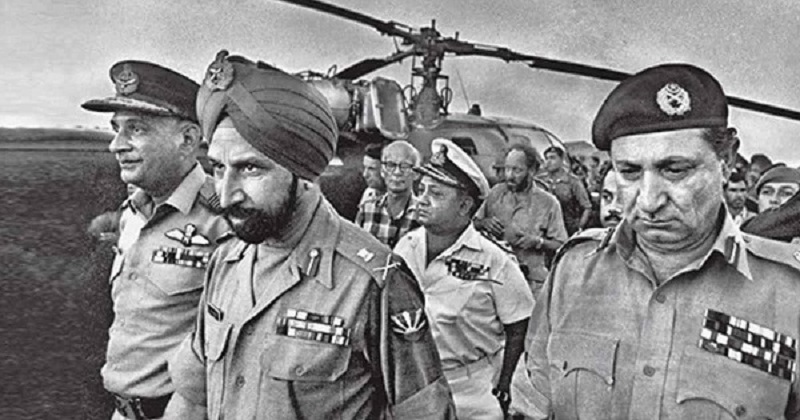
Dhaka- A fierce three-day battle took place between the Indian and Pakistani security forces in a forested finger-shaped village in a swampy area that paved the way for the final victory in the 1971 war and resulted in the formation of a new country – Bangladesh, according to the military records.
Dhaka emerged as the free capital of independent Bangladesh on December 16, 1971 after the war between India and Pakistan broke out on December 3 when the Indian troops directly stood beside the Mukti Bahini soldiers.
Bangladesh’s wartime history records that even before the Liberation War of Bangladesh started, a little-discussed but fierce three-day battle known as the ‘Battle of Garibpur’ was fought on the western borders of what at that time called East Pakistan.
The battle took place between the two forces and both sides used their tanks and airpower from November 20 to November 23.
India used Russian-made PT-76 tanks against Pakistan’s US-made M-24 Chaffee tanks, and Indian Air Force’s (IAF) Jinaat fighter jets countered attacks by Pakistani Saber F-86 fighter jets. The Pakistani side suffered disastrous losses in terms of both men and machines.
According to military strategists, the tactics of the Indian armoured troops backed by crucial artillery and Mukti Bahini support were key to the success of this crucial strategic battle, which the victors preferred to keep in a low key since the two countries were yet to enter a declared war.
“If we were allowed on that day, we could have directly driven to Joshore (deep inside Bangladesh) expediting the victory, bringing the war itself to an end,” retired armoured core brigadier Balram Singh Mehta, who took part in the battle, told PTI.
Mehta, who is in Dhaka as part of an Indian veterans’ delegation coinciding with the Victory Day celebrations, led the tank troops during the battle as the commander of his ‘C’ Squadron of Indian 45 Cavalry Major DS Narang’ was killed at the very beginning of the encounter.
Several military experts have described the ‘Battle of Garibpur’ as the biggest tank battle of the 1971 war that took place in foggy weather in a forested finger-shaped village in a swampy area on the Chuadanga border.
“After this war, the defense system of the Pakistani invaders became unbalanced…both sides fought to the best of their ability and left a large number of war lessons,” said retired Bangladeshi major general Imamuz Zaman, who is also a 1971 veteran.
Liberation War veteran retired major Nasir Uddin, who was an armoured core officer of the Bangladesh Army, said despite being light in weight with thin armour, the allied troops won the battle with an element of surprise and backup support, particularly the air power and artillery shells.
Garibpur is located 6 kilometres inside Bangladesh along India’s Boyra, on both sides of the highway from India to Jessore via Chougacha. For this reason, Garibpur is considered an important road connection between the two countries.
According to Pakistani military experts, their high command was of the opinion that this swampy area was “inaccessible to tanks” and was shocked by the presence of Indian tanks.
On the other hand, the soldiers of Mukti Bahini continuously harassed the Pakistanis there from the beginning with their hit-and-run tactics.
Various writings suggest that an accidental skirmish resulted in a Mukti Bahini patrol being spotted by a Pakistani reconnaissance group in the area, and the allies lost an opportunity for a complete surprise attack.
Then Pakistani military spokesman Major Siddique Salik later wrote in his book “Witness to Surrender” that their troops always believed the area was “inaccessible for tanks” while the battle proved that their troops had lost their staying power and, simultaneously, the fact that the “allied forces were fully determined”.
“Enemy forces (allied forces) crossed the border near Boyra (Jesore sector) on November 13. They hid there for seven days. At this time, the Indians formed two full battalions. We came to know about their presence around November 19,” he wrote.
”The attack was launched at 6 am on November 21. It progressed well initially (for Pakistanis) when the (Pakistani) attacking force advanced towards the enemy position in a grove of trees, and enemy tanks opened up from hidden positions. This was a major surprise for us because we had always regarded it as an ‘untankable’ area,” he wrote.
The military records suggested that Indian artillery forces crossed the border quickly and joined the battle. There, Pakistani troops sought the assistance of PAF fighter jets and soon after, three Pakistani Saber fighter jets were seen circling in the sky to counter the India’s Gnats fighter jets.
“The attack was then withdrawn,” Salik said.
Mehta said against the backdrop of a well-assumed imminent full-scale military warfare, the Indian forces needed some assault launching pads against Pakistani troops and “Garibpur was among the key launch pads because of its proximity to Jessore”.
Imamuz Zaman supplemented Mehta, saying the allied forces in a preliminary operation plan in mid-November decided to use as a launching pad the area around Chaugacha in Jashore for subsequent operations in enemy-occupied western region.
Bangladesh’s wartime army records suggest the Mukti Bahini guerillas found the Garibpur area to be largely uncared by Pakistanis for a major battle, a piece of intelligence, that helped the plan formulation.
Residents in the neighbourhood recalled Mukti Bahini soldier Abdus Sattar escorted the Indian tanks to the site escaping enemy eyes while fellow guerillas with villagers’ support paved the way for the tanks by putting trees on muddy paths.
Then Indian Prime Minister Indira Gandhi herself highlighted the success and importance of the war in Parliament while Salik wrote that their top commander Niazi, felt that this frontal battle had “started his all-out war”.
“The attack on Garibpur was the strongest that Pakistan launched in the war…(but) eventually as a result of this battle, Pakistan had been completely unbalanced,” Brigadier Hayat Khan, who led the Pakistan side in the battle, later said.
A total of 28 allied troops including affiliated Mukti Bahini soldiers lost their lives while 42 were wounded in the battle the Pakistani casualty was estimated to be around 300 soldiers, including three officers. Six enemy Prisoners of War were apprehended.
The international boundary along the region remained in allied hands until the final victory.
Follow this link to join our WhatsApp group: Join Now
Be Part of Quality Journalism |
Quality journalism takes a lot of time, money and hard work to produce and despite all the hardships we still do it. Our reporters and editors are working overtime in Kashmir and beyond to cover what you care about, break big stories, and expose injustices that can change lives. Today more people are reading Kashmir Observer than ever, but only a handful are paying while advertising revenues are falling fast. |
| ACT NOW |
| MONTHLY | Rs 100 | |
| YEARLY | Rs 1000 | |
| LIFETIME | Rs 10000 | |













